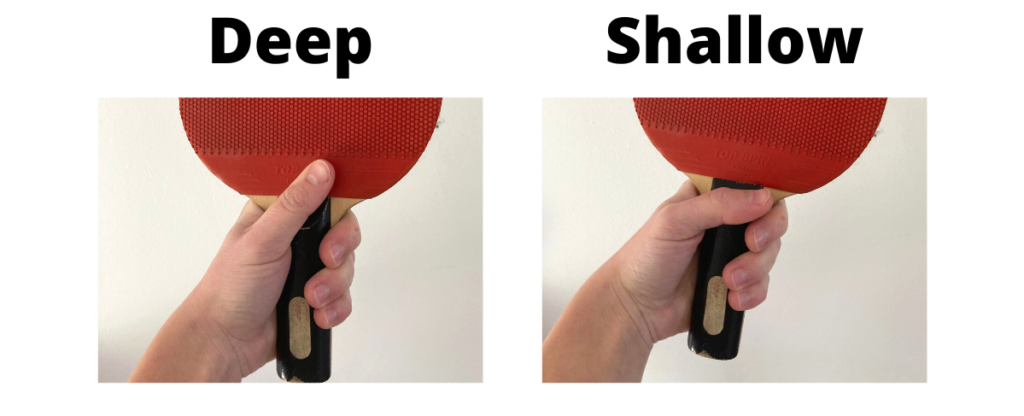Many players wonder what the best type of grip is when playing ping pong (table tennis). You may already be familiar with shakehand and penhold grips, and wonder if the one you’re using currently is the best option, or you may be a complete beginner who’s picking up a paddle for the first time.
In this article I’ll clear up the differences between penhold and shakehand grips, the different variants, and the pros and cons of each.
The Quick Answer
The shakehand grip is associated mostly with western players and the penhold grip is most often associated with Asian players. The shakehand grip feels more comfortable for most players, and offers more balance between backhand and forehand power, whereas the penhold grip increases wrist flexibility.
| Shakehand Grip | Penhold Grip |
| Limited wrist flexibility | Better wrist flexibility |
| Balanced backhand and forehand | Favours forehand (harder to perform backhand) |
| Good for playing further from the table | Good for playing close to the table |
| More powerful | Weaker shots |
| Usually comfortable for most players | Can feel uncomfortable for beginners |

What is a Shakehand Grip?
The shakehand grip is more common in Western countries including America and Europe but can also be seen in Asian countries.
In the shakehand grip, three fingers are wrapped around the handle, the index finger rests on the back of the rubber, and the thumb rests at the front (where the other three fingers end). Some players also wrap the index finger around the handle (instead of having it rest on the back) but this is usually not used.
The shakehand grip usually feels quite comfortable for beginners, and is typically the grip most players would adopt if they were to pick up a paddle for the very first time. The shakehand grip is considered quite powerful and capable of producing fast driving and looping shots.
The main issue with the shakehand grip is at the crossover point.
This refers to the switch between using the paddle with your forehand or backhand. The shakehand grip is often described as having a “point of indecision” which means it can be difficult for players to identify whether they should be using forehand or backhand which can cost them valuable time during a game situation.
However, with practice, this can be overcome as you get used to the grip more. Some players also may find that they have more limited wrist flexibility compared to when using a penhold grip.
| Advantages | Disadvantages |
| Comfortable for beginners | Point of indecision |
| Powerful shots | Limited wrist flexibility |
There are two variations of the shakehand grip: the deep grip and the shallow grip.
- Deep shakehand grip: the thumb will rest on the rubber
- Shallow shakehand grip: the thumb will rest on the top of the blade.

The shallow shakehand grip allows for more wrist flexibility which aids your ability to create spin when serving and looping.
The main issue with the shallow shakehand grip is that it can be sometimes difficult to know when you should be using forehand or backhand, leading to some hesitation that can cost you a point. Although, this is likely to become much less of an issue once you become more comfortable. The shallow grip is also not quite as firm as the deep grip, which can make it a bit less stable and precise.
The deep shakehand grip gives you a firmer grip on the paddle which can feel more accurate and precise as it essentially gives you more control. It also shares it can be difficult to decide whether you should be using forehand or backhand for a particular shot, but this will become easier with more practice (same as the shallow grip).
| Shallow Shakehand | Deep Shakehand |
| Good for looping, driving and topspin | Good for backspin and defensive play |
| More wrist flexibility | More control (firm grip) |
What is a Penhold Grip?
The penhold grip is popular with table tennis players in Asian countries such as Japan, Korea and China. This grip usually feels slightly more awkward for beginners, and typically if you were to pick up a paddle for the very first time you wouldn’t naturally grip it in this way. However, many young players are taught using the penhold grip and feel very comfortable with it.
The main advantage of the penhold grip is that it does not have the “point of indecision” that the shakehold grip suffers from, as it allows the wrist to move more freely. They are preferred by players who sing blocking techniques, and they also allow for excellent power with pretty much every type of serve.
The main disadvantage of the penhold grip is that it can feel quite unnatural for new players, and it also makes backhand spin quite difficult to perform. Additionally, the elbow is usually closer to the body with a penhold grip, which can limit the space you can cover across the table, making good footwork essential.
| Advantages | Disadvantages |
| No “point of indecision” | Hard to perform backhand spin |
| Good for blocking and driving | Better footwork is required |
| Better wrist flexibility | Can feel unnatural for beginners |
Notable players who use or currently use the penhold grip include Xu Xin, Ma Lin, and Wang Hau.
There are also a two different types of penhold grip.
- Traditional Chinese penhold grip: the thumb and index finger are curled around the top of the blade, and the three fingers on the back of the bat are curled.
- Japanese/ Korean penhold grip: the thumb and index finger are curled around the top of the blade, and the three fingers on the back of the bat are straight.

The main difference between the Chinese and Japanese/ Korean penhold grip is regarding the positioning of the three fingers on the back of the paddle. With the Chinese grip, the fingers are curled to aid flexibility, whereas with the Korean/ Japanese grip, the fingers are straight to increase power.
| Traditional Chinese Penhold | Korean/ Japanese Penhold |
| Fingers on the back of the bat are curled | Fingers on the back of the bat are straight |
| Maximises wrist flexibility | Straight fingers reduce flexibility |
| Less power | Increased power |
| Better when close to the table | Better for when further from the table |
Frequently Asked Questions
Here are the answers to questions you may still be asking about the different table tennis grips.
How do professional ping pong players hold the paddle?
Most professional ping pong players use a shakehand grip when holding the paddle, however some Asian players will use a penhold grip instead.
What is the best way to hold (grip) a ping pong paddle?
The best way to hold a ping pong paddle is by using either the shakehand or penhold grip. The shakehand grip feels more comfortable for most players and results in a balanced backhand and forehand, however the penhold grip offers better wrist flexibility. The best grip to use is whichever feels more comfortable for you.
What are all the different types of table tennis grips?
There are two main types of ping pong paddle grip: shakehand and penhold. Shakehand is the most popular and has two variants: deep grip shakehand and shallow grip shakehand. Penhold grips also have two variants: the traditional Chinese penhold grip and the Japanese or Korean penhold grip.
Check out my comparison between flared, straight and anatomic handles.
